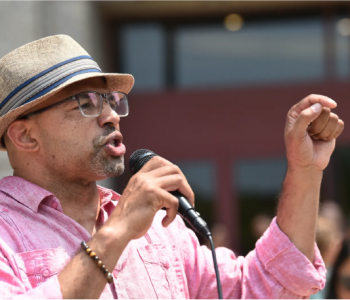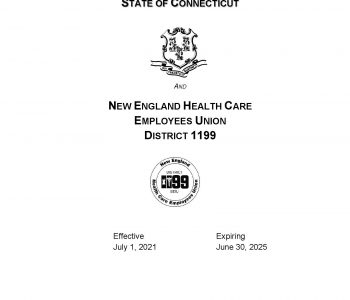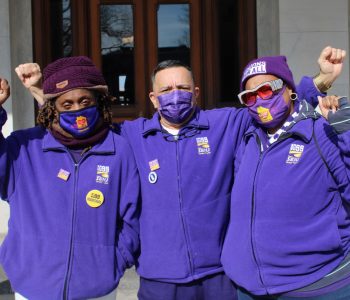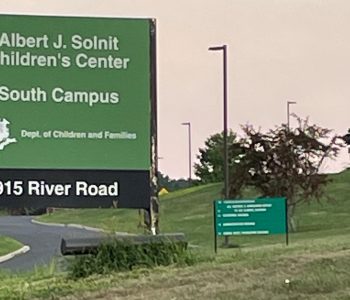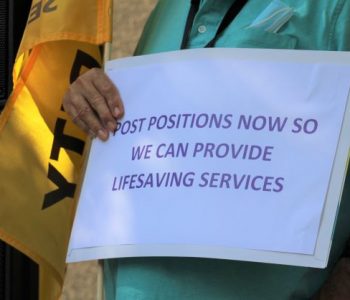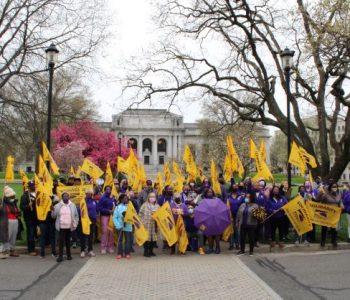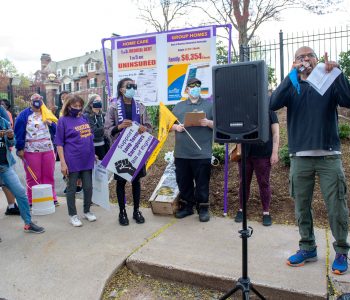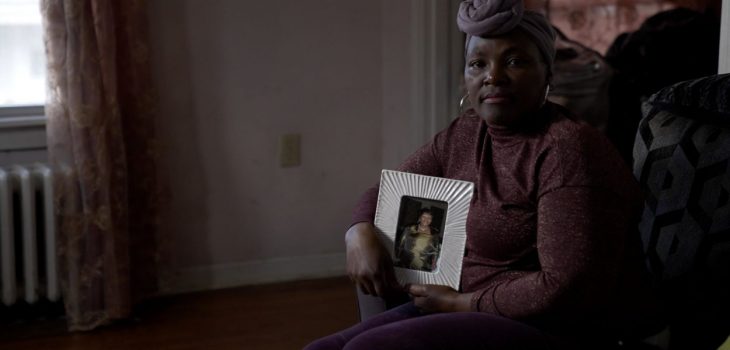 Connecticut
Connecticut
Grace Davis was born during the Spanish flu and outlived two husbands. At 101 years old, she was still going strong when COVID-19 began its lethal spread through Connecticut’s nursing homes.
Then in May, she caught the disease.
“At first my symptoms were like what the flu would have been,” she said in a Zoom interview from her room at the Mary Wade nursing home in New Haven. “It’s a little vague now, but I was very ill.”
Unlike thousands of others in nursing homes across the state, Davis survived. She recently received her second dose of the Pfizer vaccine and is looking forward to her 103rd birthday on May 2.
Grace Davis, a resident of the Mary Wade nursing home in New Haven, caught COVID-19 but survived. “I’ll never forget this,” she said.
Davis is glad that she and other residents at her facility are no longer “petrified that tomorrow we’re going to pass.” Sixty-one people at her home were infected, and 29 died of coronavirus.
“I don’t remember the Spanish flu because I was born that year,” she said. “But I’ll never forget this.”
For many living in Connecticut’s nursing homes, the traumatic events of the past year are still top-of-mind.
As of March 16, the most recent data available, 3,864 residents of those facilities had died of COVID-19, and 13,986 contracted the disease. At the height of the pandemic, nursing home deaths represented more than 60% of Connecticut’s overall coronavirus fatalities. This month, they still account for half of the state’s total COVID deaths.
In the early days of the crisis, nursing homes scrambled to separate sick residents from healthy ones. Despite warning signs from long-term care facilities elsewhere in the country and overseas, the state’s early, limited supply of testing materials was mostly directed toward hospitals and other urgent care centers. It took months for nursing homes to begin testing all of their residents and staff to identify asymptomatic carriers.
“What we know about COVID that we didn’t then was just how contagious it really was,” said David V. Hunter, president and CEO of the Mary Wade Home. “We didn’t know you could have COVID and not have symptoms and be walking around infecting others.”
The state set up special facilities, known as coronavirus recovery centers, to treat COVID-19-positive nursing home residents – an effort to separate the infected population and stem the spread. But the first recovery center didn’t open until mid-April, over a month into the pandemic. By then, 108 nursing homes – over half of the total buildings – had at least one coronavirus case, and many had dozens.
Guidance from federal agencies and the state seemed to change almost daily, and industry officials struggled to keep up. Shortages of personal protective gear meant masks and other equipment were recycled, sometimes for days, and certain types of resident care were put on hold.
Months into the pandemic, the state hired an outside agency to investigate the response of nursing home leaders and elected officials to the crisis in Connecticut’s long-term care facilities. The firm, Mathematica, outlined numerous lapses, including the state’s decision to focus on hospitals instead of nursing homes at the beginning of the pandemic and a failure to fill six of nine key positions in the office charged with managing public health emergencies.
Mathematica also found that facilities did not take swift action to limit entry into their buildings, enforce staff screening measures and implement universal mask-wearing early on.
Lawmakers, now in session, are weighing reforms that could include cameras in nursing homes, mandated training on infection prevention and higher minimum staffing requirements. Advocates are pressing for broader visitation opportunities, and facility leaders are contemplating the future of nursing homes as occupancy declines.
“Long term, the virus will make our industry change,” said Paul Liistro, who owns nursing homes in Manchester and Vernon. “There is a greater focus on infection prevention than ever before, a focus on private rooms and private bathrooms, and on better air filtration.”
The COVID-19 vaccine has offered a glimmer of hope. By Friday, 18,716 nursing home residents had received a first dose of the shot; 14,851 were fully vaccinated – more than 80% of the total population, according to Gov. Ned Lamont’s office. Among the staff, 19,308 had received a first dose and 16,742 were fully vaccinated.
“We would not be able to say this is over for us yet, but the data, the metrics are all very promising,” said Matthew Barrett, president and CEO of the Connecticut Association of Health Care Facilities. “We can see the other side of this pandemic.”
More visitation?
The first case of COVID-19 was recorded in Connecticut on March 6, a Friday. By the following Monday, the state had directed all nursing homes to cease visitation, except in cases where a resident was dying.
YEHYUN KIM :: CTMIRROR.ORG
Sofia Agranovich has lunch at Beechwood Rehabilitation and Nursing Care in New London. It was the third day that a limited number of residents were allowed to have meals together in the dining room.
The shift was a frightening adjustment for Maureen McElaney and her 83-year-old mother, who lives at the Notre Dame Health and Rehabilitation Center in Norwalk. Barbara McElaney has dementia and was seeing her children on a near-daily basis before the pandemic.
“It was horrible,” Maureen said. “She feels it when she doesn’t see us. There are four kids in the family, three that live around here. Prior to COVID, we had a thing where we could never let, like, more than a day go by without one of us going. She would get so upset when she didn’t see us.”
By the time the family was reunited at an outdoor visit last summer, Barbara McElaney had declined physically – she wasn’t eating or drinking enough, and she could barely hold her head up. Rules prevented her children from hugging her or helping her eat.
Barbara’s condition improved with more frequent outdoor visits, but by fall, as COVID-19 cases swelled again, most of the family’s interactions were done through a window or over FaceTime. When Barbara’s health worsened this winter, Maureen and her siblings were able to go into the facility with protective gear.
But Maureen is still waiting for the home to loosen restrictions so she can have more meaningful time with her mother. Both of them have now been vaccinated, she said.
“The hardest part about COVID has been not being able to see my mother regularly,” Maureen said. “You feel helpless.”
While coronavirus tore through nursing homes, infecting and killing thousands, a second crisis was unfolding in the facilities: loneliness.
Face-to-face interactions with family members were curtailed for much of the pandemic, and routines that residents had come to know – group dining and television watching, social exchanges in common rooms – vanished.
YEHYUN KIM :: CTMIRROR.ORG
Charles Miller watches television while having lunch at Beechwood. Family visitation at the nursing home slowly opened up from window visits to in-person visits. Miller is able to meet his wife twice a week.
Patient advocates reported rising rates of depression and anxiety. Some nursing home residents went six months or longer without seeing their loved ones.
After a year with varying degrees of restriction, the Centers for Medicare and Medicaid issued new guidance this month, saying facilities should allow visitation at all times, for all residents, regardless of whether a resident or visitor has been vaccinated. There are exceptions: the visits may be limited if the county positivity rate exceeds 10% and fewer than 70% of residents in a facility are fully vaccinated; if a resident has a confirmed case of COVID-19; or if a resident is in quarantine (vaccinated or not), until they have met the criteria for release.
Compassionate care visits – interactions with people whose conditions have deteriorated – should be permitted at all times, the guidance says, regardless of a resident’s vaccination status, the county positivity rate or an outbreak at a facility.
Visits can now take place in residents’ rooms; under previous rules, the meetings were required to happen in a designated space – such as a conference room or common area – that could be sanitized between meetings. And while CMS continues to recommend social distancing and mask wearing, close contact, including touch, is allowed for residents who have been fully vaccinated.
Prior to this month’s policy change, indoor visits were permitted but could be halted under a variety of circumstances, including if a single COVID-19 case was detected in a nursing home.
Advocates praised the newest guidelines but said they must be applied consistently across the state’s nursing homes. One of the biggest challenges with these policies is uneven adoption, they said.
“That disconnect has been incredibly frustrating for family members who just want to know, ‘Can I see my husband today? Is it OK to hug my mom?’ From one facility to the next, sometimes it seems to be ‘yes,’ and sometimes it seems to be ‘no,’” said Anna Doroghazi, state associate director for advocacy and outreach at AARP in Connecticut.
“Some family members have been able to hug vaccinated loved ones and others have only been permitted to have window visits. That feels symbolic of something we’ve seen this entire pandemic – there have been so many rules at the state and federal level, but in a lot of circumstances, that’s not what residents and family members are experiencing on the ground.”
YEHYUN KIM :: CTMIRROR.ORG
Residents at Beechwood have lunch together in a dining room while social distancing. Residents previously had meals in their own rooms throughout the pandemic.
Mairead Painter, Connecticut’s long-term care ombudswoman, said the state’s nursing homes are probably reluctant to ease visitor restrictions because of the rapid spread of the virus. But with more than 3 million nursing home residents and staff vaccinated nationally, she said, managers should adhere to the latest guidance.
“The homes have been so traumatized. They’re afraid to let people in,” she said. “Now that we have new guidance, it’s critically important that homes move this forward.
“We heard throughout the pandemic that residents and family members felt [the restrictions were] done to them. Not with them, but to them. They want to be included in the decisions about their lives.”
Connecticut’s AARP is recommending that resident care plans address isolation, risk for depression and the ability to interact with loved ones. The organization has also called on nursing homes to ensure residents have myriad ways of connecting with family – from phones to iPads.
“I think family members and residents would still say that loneliness is a crisis,” Doroghazi said. “My hope is that the new CMS guidance will be the beginning of the end of that crisis.”
A push for better care
Though nursing homes moved quickly to enact safety measures that would protect residents from COVID-19, everyday care became a challenge in some facilities during the pandemic.
Painter said people have complained to her office about residents spending longer periods of time in their rooms awaiting care. Showers for residents were scaled back or eliminated completely in many facilities at the height of the pandemic because staff members burned through protective gear by helping people get clean. In some homes, people were being sponge-bathed in bed as an alternative.
“We heard about individuals waiting much longer to go to the bathroom, not being able to get up and go even close to the normal times they were used to,” Painter said. In some cases, it was difficult “just being able to ask for things. The amount of time that staff had per resident to be able to provide them with nutritional support and feed them was impacted, and if there was active COVID, it was even further impacted.”
YEHYUN KIM :: CTMIRROR.ORG
Miller watches television while having lunch.
Other concerns, including residents going weeks or months without haircuts or nail clippings, have been reported. With visitation limited, family members who regularly had been helping to cut nails or provide other hygiene services were unable to do so. Stricter visitation rules meant hairdressers were barred from entering many facilities, and certain types of medical care were put on hold.
“Unfortunately, unless the person had diabetes, a podiatrist wasn’t seen as a priority,” Painter said. “And then, even in some of those cases, they did not get out to the podiatrist, and we had cases of individuals with significant toenail issues.”
Showers resumed as homes received increased shipments of personal protective gear, though advocates say the frequency has not returned to pre-COVID levels. Hairdressing and foot care have also started up again at some nursing homes, but access varies by facility.
Advocates are now trying to address resident care by pressing for more mandated staffing hours. The state’s public health code requires 1.9 hours of nursing staff care per resident each day. Organizations like the AARP are pushing for a mandatory minimum of 4.1 hours, echoing recommendations by the Centers for Medicare and Medicaid Services.
Some Connecticut nursing homes average three hours or more per resident each day, but advocates say the mandatory minimum should be higher than four. For residents, that extra time could mean being fed another meal or taking showers more frequently.
“Low staffing levels mean that residents cannot get out of bed, use the bathroom or eat in a timely manner,” Nora Duncan, state director for the AARP in Connecticut, wrote in a letter to lawmakers and Department of Public Health staff at the beginning of the 2021 legislative session. “Staff risk physical injury and cannot give residents the time and attention they deserve; visits with loved ones may be limited or cancelled; and it is more difficult for facilities to contain the spread of COVID-19 and other infectious diseases.”
Legislators are weighing a bill that would increase the mandatory minimum hours of direct care to 4.1 per resident per day. The measure ties in other proposals to improve care, such as requiring facilities to maintain at least a three-month supply of protective gear, mandating that they have at least one employee on each shift who is licensed or certified to start an intravenous line, and requiring every administrator to complete an infection prevention training course.
The bill would also allow cameras to be installed in resident rooms under certain circumstances.
AP PHOTO
Jeanne Peters, 95, a resident at The Reservoir nursing home in West Hartford, receives a COVID-19 vaccine. The Reservoir was among the first nursing homes in Connecticut to begin vaccinating its residents against coronavirus.
Barrett, the head of the Connecticut Association of Health Care Facilities, said he strongly supports increased staffing in nursing homes, but more money is needed from state and federal agencies to make it happen. Medicaid covers the cost of roughly 70% of all nursing home care provided in Connecticut, and Medicare covers about 15%.
Barrett noted that Lamont has proposed flat-funding the homes for the next two years.
“A significant infusion of dollars is needed to address these staffing issues,” he said.
Occupancy plummets
In February 2020, just before the first case of COVID-19 was reported in Connecticut, nursing homes were 87% occupied on average, state data show. By last month, the average occupancy had fallen to 72%.
The facilities faced a sharp drop in revenue from fewer people seeking rehabilitation and other post-acute care. At the same time, some families were pulling their loved ones out of the homes, and others opted against putting their relatives in those facilities.
The homes also endured increased costs for protective gear and staffing.
Despite receiving tens of millions of dollars in additional aid from the state last year, Barrett said, nursing homes, which were running on narrow margins before the pandemic, are still financially strapped.
He has made a case to the state legislature for hundreds of millions in additional funds, including $277 million, or a 15.6%, Medicaid rate increase, to bring mandatory minimum staffing to 4.1 hours of direct care per resident per day. Another $177 million would offset the loss of funds from the drop in occupancy, Barrett said, and an additional $135 million would help balance the underfunding of nursing homes that began pre-pandemic.
CLOE POISSON :: CTMIRROR.ORG
Francene Bailey is comforted by family members as she weeps at the burial service for her mother, Hazel Bailey, in Bloomfield last May. Hazel died of COVID-19 at age 73. Francene, who worked as a certified nursing assistant at Kimberly Hall North, tested positive for the virus in late March.
“At this critical juncture, a substantial funding increase is imperative so nursing homes can deliver the high-quality care we know everyone wants as they recover from this epic pandemic that has caused so much heartbreak and tragedy,” he testified.
Though the facilities are mired in a financial crisis, industry leaders say they are optimistic that occupancy will rebound and the homes will return, at least somewhat, to their previous vibrancy.
“People are concerned about nursing homes and now may think twice about putting their grandmother in one, but it is very expensive to provide home health care, and eventually people may come back,” said Liistro, the owner of nursing homes in Manchester and Vernon.
As more people return to the office from a year of telecommuting, Barrett said, he expects the nursing home census to rise.
“Will we ever return to a pre-pandemic normalcy? That’s anybody’s guess,” he said. “But we are going to be moving in that direction. I think consumer confidence is going to rebound.”
Persistent trauma
For many nursing home workers, the scars of the past year are still fresh.
Francene Bailey, a former certified nursing assistant at Kimberly Hall North in Windsor, one of the hardest hit facilities in Connecticut, said she still feels responsible for the death of her 73-year-old mother, Hazel Bailey.
Francene believes she contracted COVID-19 at the nursing home, where she had worked for 25 years, and passed it to her mother one fateful day when the two embraced. Francene had been feeling sick while awaiting the results of a coronavirus test, and she tumbled down the stairs of her two-family home in Hartford gasping for air. Her mother caught her at the bottom, and asked her to remove her surgical mask so she could breathe better. She did, and the two hugged.
COURTESY OF SEIU 1199
Francene Bailey believes she contracted COVID-19 at the nursing home, where she had worked for 25 years, and passed it to her mother one fateful day when the two embraced.
“She said, ‘Take the mask off.’ If I had known, I wouldn’t have taken it off, and she would still be here,” Francene said through tears in an interview recorded by her union, SEIU 1199. A video of the interview, in which she reflects on the hardships of the past year, was shared with The CT Mirror.
Hazel Bailey showed symptoms of COVID-19 less than a week after Francene’s test result came back positive. Hazel died three weeks later.
“All I could say was, ‘Oh God, I killed her,’” Francene recalled. “They keep saying, ‘Don’t blame yourself’ … How can I not blame myself? If it wasn’t for me, she wouldn’t have gotten sick.”
Francene has also struggled with the long-term effects of the disease. She has trouble getting up and down the stairs. Her joints are stiff. Although she is negative for the virus, she continues to cough, and her anxiety remains high.
“I get so angry when people look at me and say, ‘You’re still coughing?’” Francene said. “They don’t know what I go through. I’m not an old person. I’m 48 years old.
“When I cough, people are scared of me. And I have to say, ‘I don’t have COVID, it’s just a cough from when I had COVID.’ They still look at me like I’m an alien.”
Zina Bennett, a certified nursing assistant at St. Joseph’s Center in Trumbull, where 129 people have contracted the disease and 45 have died, has seen up close the suffering and pain her residents and colleagues experienced.
People she had formed attachments with during her six years at the facility got sick and died. One of her closest friends – who also works at St. Joseph’s – fell ill and passed the virus to her husband and three children.
COURTESY OF SEIU 1199
Francene holds a picture of her mother. Hazel Bailey showed symptoms of COVID-19 less than a week after Francene’s test result came back positive. She died three weeks later.
“Some of the roughest times were seeing your residents pass away,” Bennett said in an interview with CT Mirror. “We have residents who survived, but even watching them go through the process of it was hard.”
“Finding out your co-workers tested positive was also difficult,” she said. “Some of my co-workers actually took it home to their families. And some of them lost a few family members.”
At one point, Bennett thought she had unwittingly infected her oldest son, a 13-year-old with asthma. “We thought, ‘Oh my God, he’s asthmatic.’ That process was scary, even to know you have to get your kid tested, and knowing you’re the only one who could have brought it to them.”
Bennett and her son were both negative for COVID-19.
Since last March, at least 9,365 nursing home workers in Connecticut – about a third of the workforce – have contracted coronavirus, and at least 17 have died, federal data show. Advocates say the numbers are likely higher, since many employees quarantined with symptoms but did not have good access to testing in the early months of the pandemic.
The hardship of working in a nursing home amid COVID-19 led to waves of retirements and other departures. Many still suffer from post-traumatic stress disorder, having been subjected to the constant fear of catching the virus and spreading it to loved ones, and of watching residents die.
Advocates and union leaders are calling for better pay, paid time off and increased staffing levels to ease the workload and anxiety that employees face.
“COVID has made staffing worse,” said Jesse Martin, a vice president with SEIU 1199, which represents about 6,000 nursing home workers in Connecticut. “No one is excited to come into this field to work for terrible wages and benefits. The current staff are tired; [some] have to struggle to get time off. And employers are putting a tremendous amount of pressure on workers to do more with less.”
Renewed hope
Charlie Miller counts himself among the lucky ones. The 73-year-old nursing home resident caught COVID-19 but survived.
Miller spent time in one of the state’s coronavirus recovery centers – the facilities dedicated to caring for nursing home residents who test positive – in October. He remained in the Meriden building for two weeks and was transferred to Beechwood Post-Acute & Transitional Care Center in New London after getting better.
He has no lingering symptoms.
“I’ve been very lucky,” Miller said. “It could have been a lot worse for me.”
Bennett, the nursing aide at St. Joseph’s, said despite the difficulty of the last year, she’s not ready to step away from her job. She got into the field because she likes people, and that hasn’t changed.
“Somebody has to do this job, and why not me, who has the love, the compassion and the patience?” she said. “I look at these residents and they could be my grandma; they could be my aunt. Everybody needs somebody, and for them, I’m that somebody.”
COURTESY OF SEIU 1199
“I get so angry when people look at me and say, ‘You’re still coughing?’” Francene said. “They don’t know what I go through. I’m not an old person. I’m 48 years old.”
She still takes precautions and prays before each shift. But the mood at her nursing home has brightened. With many of the residents vaccinated, they are able to leave their rooms and engage in some recreational activity. There’s a heightened sense of relief.
“The residents are starting to smile again,” Bennett said. “Even though the storm is not over, we got through a big part of it. There’s some sunshine coming out. I would say the clouds are starting to open up and let the sun in a little bit.”
Original Article from The CT Mirror

